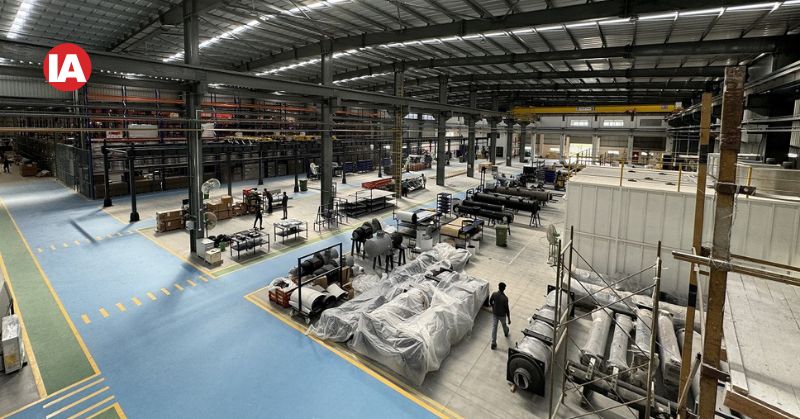
The Role of Compressed Air in Evolution of Automotive Industry
Compressed air plays a pivotal role in the automotive manufacturing process, powering everything from assembly tools to painting systems. Bhushan Bokil, Business Marketing Manager at Atlas Copco Compressor Technique, highlights how leveraging the right compressed air systems enhances efficiency, ensures quality, and supports the evolving demands of the automotive sector.
![[object Object]](https://admin.industrialautomationindia.in/storage/articles/article-yW5oTrMzEMpsAnPLqrL3zCJkE5E0Ne4YvhCBNCcf.jpg)
By leveraging the power of compressed air, automotive manufacturers can enhance efficiency and maintain high product quality, says Bhushan Bokil.
The global automotive industry has seen remarkable changes over the past two decades. From the rise of electric vehicles (EVs) and two-wheelers to the advent of self-driving and connected cars, technology is revolutionising how we drive and maintain our vehicles. Despite these advancements, the core processes of vehicle manufacturing have largely remained consistent. Cars are still assembled on production lines, with parts being put together by skilled workers or automated robotic systems.
One crucial element that powers these manufacturing processes is compressed air. This utility is indispensable across various stages of vehicle production, from assembly to engine construction, painting, and cleaning. Compressed air is also vital in the auto tyre industry, making it a ubiquitous asset from large corporate assembly lines to local auto body shops.
The role of compressed air in vehicle assembly
During the assembly process, compressed air tools are used to create auto parts and power machines that lift, position, and fasten components. This includes forming critical vehicle parts like door panels and trunks. Air compressors are essential for powering equipment used in both the assembly and maintenance of vehicles.
In the automotive sector, it serves multiple purposes, including:
• Powering pneumatic tools
• Automation and control systems
• Cleaning and drying operations
• Manufacturing interior plastic seating and shielding
• Producing transmissions, brakes, discs, and batteries
• Pressing auto components
• Foundry and forging operations, and
• Painting and more.
By following industry best practices, automotive manufacturers can maximise the efficiency and quality of their compressed air systems.
Choosing the right compressed air system

Selecting an appropriate compressed air system for automotive applications depends on the average airflow (measured in cubic feet per minute or cfm) and the air pressure required for specific tools. These requirements can vary significantly across different manufacturing plants and workshops.
In automotive servicing and repair, workshops use air compressors for tasks such as painting vehicles, inflating tyres, and operating equipment like power grinders, wrenches, and sanders. Heavy-duty jobs like sanding and painting typically require higher airflow, while tasks like vehicle body cleaning and tyre inflation need lower volumes. Most air-operated tools function optimally at around 6.2 bar, with paint guns requiring 2.5 to 4.1 bar, tyre inflation needing about 8.9 bar, and truck jacks demanding 11.4 bar. Air compressors with standard operating pressures of 7, 8, 10, or 12.5 bar can handle various mechanical tasks in automotive workshops.
It’s important to note that air compressor systems offer higher airflow at lower pressures and lower airflow at higher pressures. Therefore, choosing the correct pressure is crucial to ensure adequate airflow for all equipment.
Compressed air in auto assembly
Compressed air is integral to nearly every process in the automotive industry, from engine construction to vehicle assembly, painting, and cleaning. Recent technological advancements have reduced the weight of modern vehicles, which now include a mix of lightweight metals, plastics, and composites. Pneumatic tools help create these parts and power machines that lift, transport, position, and fasten components. Metal forming machines use compressed air to turn sheets of metal into essential vehicle parts.
Robots and factory workers use pneumatic fastening tools and compressed air to assemble vehicle components, producing the unpainted car body. After assembly, vehicles are cleaned and painted using dry, oil-free compressed air. Any water or contaminants in the air during painting can cause defects, so modern air compressors come with filters and dryer technologies to purify the air.
For tasks requiring absolutely dry and clean air, oil-free air compressors are recommended. These are essential for applications like car surface cleaning and spray painting, where clean compressed air ensures high-quality finishes and prevents equipment damage.
Conclusion
Compressed air systems are the multitaskers of the automotive industry. Choosing the right unit depends on the scale of operations and future expansion plans. By leveraging the power of compressed air, automotive manufacturers can enhance efficiency and maintain high product quality.
Link: Atlas Copco Compressor Technique: https://www.atlascopco.com/en-in/compressors
Bhushan Bokil is Business Marketing Manager, Atlas Copco Compressor Technique, Atlas Copco (India) Private Limited.
Climaveneta to invest Rs 400 crore in manufacturing facility near Bengaluru

Climaveneta Climate Technologies, a Group company of Japanese multinational Mitsubishi Electric, is investing over INR 400 crore in the state-of-the-art plant at Narsapura, Kolar district, a key industrial hub located around 50 kms from Bengaluru. Climaveneta is a leading manufacturer of high efficiency cooling equipment, and precision as well as data centre cooling systems. Presently having an order booking of over INR 500 Cr, the company is targeting to double the annual order intake in next 5 Years.
Climaveneta Climate Technologies (CCT), India’s fastest growing chiller producer and market leader in Co-location DC Chillers in India, will also be a major export hub in cooling systems for nearby regions. The state-of-the-art plant will manufacture central air-conditioning equipment such as Screw Chillers, Magnetic Levitation Technology Chillers, Scroll Chillers, Conventional Centrifugal Chillers, High Precision AC units, Heat Pumps, for HVAC application. CCT Serves major clients all over India, that includes leading global DC companies, multinational hotel chains, health care establishments, malls, multiplexes, commercial projects of leading developers, corporate groups and industrial applications.
Mr Anil Dev, Chief Executive Officer, Climaveneta Climate Technologies, India, said: “India’s rapid digitalisation, driven by government initiatives, e-commerce, cloud adoption, and AI, calls for a strong data centre infrastructure, to support this growth. Reliable cooling systems are essential to prevent equipment failures in data centres. CCT’s advanced, sustainable, and efficient air conditioning solutions ensure ideal environments across data centres, commercial buildings, healthcare, manufacturing, and more, supported by intelligent plant automation and optimisation solutions to provide the most reliable and efficient environment & infrastructure for such projects.
Climaveneta India is building on the high demand and growth story of the data centre markets in India. This market is concentrated largely in West India (Navi Mumbai), followed by Chennai, Bengaluru, Hyderabad, Pune and Kolkata. The company is also a leader in providing other highly efficient HVAC products and solutions and has to their credit several innovations introduced by them in India.
“Bengaluru, with its skilled talent and established industries, is ideal for our facility, which will create approximately 500 jobs. It will also manufacture a wide range of central air conditioning equipment for both domestic and international markets. We will always strive to bring efficient technologies to the Indian market and pursue ethical growth by giving highest priority to sustainability and protection of the environment,” added Anil Dev.
HVAC equipment accounts for a significant portion of a facility or a building’s energy consumption and operating costs. HVAC monitoring & diagnostic systems can help to lower these expenditures by continuously monitoring the environmental conditions, health and operating efficiency of the plant, providing automatic alerts in case of deficiency in performance. They also help to minimise breakdowns.
Mr Masafumi Ando, Chief Executive Officer, Mitsubishi Electric Hydronic and IT Cooling S.p.A, said: “The group is targeting 2050 for achieving complete carbon neutrality and Climaveneta India is playing a major role in this plan. Climaveneta India’s products are vital now given the buoyant Indian economy and also the sudden and rapid change in industrial dynamics. Europe and many developed countries are phasing out refrigerants that have global warming implications and hence alternative technologies are the need of the hour. The company’s products ensure zero percent ozone depletion and the current high demand for environment friendly and energy efficient cooling systems reflects this change.”
“Mitsubishi Electric plans to enhance its investment over the next few years and expand operations in and around Bangalore as well as other locations. The vast availability of skilled manpower and the presence of manufacturing and technology companies in the city and a favourable government policy is the biggest pull factor for Mitsubishi Electric,” said Atsushi Takase, Managing Director, Mitsubishi Electric India.
Apart from Climaveneta India, the Mitsubishi Electric Group already has two more of its companies in Karnataka region – Mitsubishi Elevator India Private Limited (IMEC) and Toshiba Mitsubishi-Electric Industrial Systems Corporation (TMEIC), a 50-50 joint venture between Japan’s Toshiba Corporation and Mitsubishi Electric Corporation, which manufacture Elevators, Escalators & UPS Solutions, respectively.
______________________________________________________________________________________________
For a deeper dive into the dynamic world of Industrial Automation and Robotic Process Automation (RPA), explore our comprehensive collection of articles and news covering cutting-edge technologies, robotics, PLC programming, SCADA systems, and the latest advancements in the Industrial Automation realm. Uncover valuable insights and stay abreast of industry trends by delving into the rest of our articles on Industrial Automation and RPA at www.industrialautomationindia.in